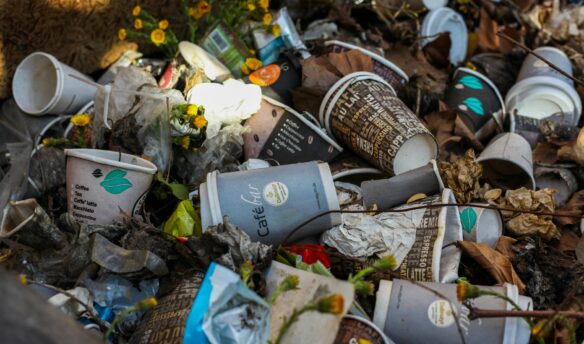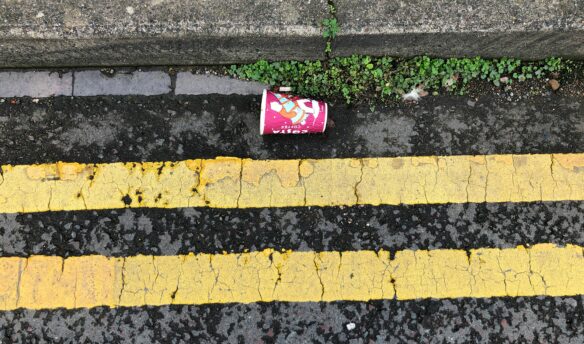Next up in the Starbucks “back-to-the-coffee-shop” plan: corporate layoffs. Plus, new migration laws in Nicaragua leave Costa Rican farmers with unharvested coffee, and it’s bistros versus baristas in Paris.
‘Costa Rica Coffee Crisis Labor Shortage Leads to Major Crop Loss’ – via Tico Times
Like many coffee-producing countries, Costa Rica relies on migrant seasonal labor to assist with the coffee harvest. However, new laws in neighboring Nicaragua are impacting this year’s harvest, with upwards of 15% of beans not being picked.
Nicaraguan President Daniel Ortega announced reforms to the country’s migration laws in November 2024, including jail time and fines for those who seek to “enter, leave, or attempt to leave the national territory in an irregular manner,” according to Tico Times. While intended to target opposition activists and politicians looking to flee Ortega’s regime, the reforms have also impacted coffee pickers who live in Nicaragua and travel to neighboring countries during harvest.
In a typical year, Costa Rica relies on at least 25,000 coffee pickers, mostly from Nicaragua, to travel to the country. According to Costa Rica’s Ministry of Agriculture and Livestock, fewer than 50 workers from Nicaragua have entered the country during the current harvest season.
The lack of workers meant farmers couldn’t harvest cherries quickly enough, and unseasonable rains in December “caused a significant percentage of the grain to fall,” said Martín Hidalgo from the Instituto del Café de Costa Rica (ICAFE).
Labor shortages in Central America are an ongoing problem, with several countries seeing a drop in workers in recent years as migrants go north to the United States. In recent years, Costa Rica has worked to provide coffee pickers with health benefits and fair compensation. This year, ICAFE started a campaign to encourage more Costa Ricans to assist with the harvest.
Farmers are hopeful it will work: “Perhaps it is not seen as a lucrative activity, as in the time of our parents or grandparents; however, it is still a very good source of income,” said Dennis Campos from Finca María Auxiliadora.
‘Starbucks to Reduce Corporate Headcount Globally’ – via World Coffee Portal
For the past eight months, we’ve followed new Starbucks CEO Brian Niccol’s plan to turn the company around in the face of falling sales. Known as “Back to Starbucks,” the plan involves offering comfier seating, nixing discounts, and creating a more streamlined menu. But now comes the ax: layoffs.
In an open letter published on the company’s website, Niccol announced that Starbucks would lay off people in their corporate office. He described the layoffs as “thoughtful” and part of an attempt to “operate more efficiently.” Starbucks, Niccol wrote, needs to “meaningfully change how our support teams are organized and how we work, making sure that we have the capacity and capabilities to deliver on Back to Starbucks, and are prioritizing the areas that have the biggest impact on the experience in our stores.”
Exactly how many people will lose their jobs isn’t clear—Niccol said the changes will be formally announced by early March. Starbucks employs more than 360,000 people worldwide, with about 16,000 working in corporate support, roasting, distribution, warehousing, and store development.
‘It’s Zinc Bar vs. Barista in a Paris Battle of the Buzz’ – via the New York Times
Paris is famous for its cafes and bistros, many of which are identifiable by their striped canopies and sidewalk seating. However, the number of cafes and bistros has fallen over the past few decades in the face of competition from chains and changing consumer habits.
As Vivian Song reports for the New York Times, another challenger has emerged in recent years: the specialty coffee shop.
“Do coffee shops pose a danger to us? The answer is yes,” said bistro owner Alain Fontaine. The number of specialty coffee shops in France has risen 74% since the early 2010s, while the number of bistros and cafes has fallen from 200,000 in the 1960s to around 40,000 today. Song writes that coffee shops “have increasingly poached the attention, time and euros of Parisians as well as the millions of international travelers who visit the French capital every year.”
In September 2024, after a petition started by Fontaine, the French government added cafes and bistros to the National Inventory of Intangible Cultural Heritage. This list includes important French buildings, foods, skills, and festivals in a bid to protect and celebrate their historic and cultural value.
Specialty coffee shops appeal to a younger generation, Song reports, while the bistros and cafes have an older customer base. Some think there is room for both to flourish. “I don’t think we have the same clientele,” said cafe manager Jérôme Martinho.
Fontaine remains pessimistic, worrying that bistros like his will become obsolete in the near future: “There’s no depth to the coffee shop, there’s no history, there’s no patina,” he said.
‘This Company Wants to Pay You to Travel and Drink Coffee’ – via Vice
Another recurring theme of this newsletter is analyzing so-called “job postings” that are secretly promotional campaigns or marketing tools. We’ve seen coffee companies advertise a fun-sounding new role that’s actually designed chiefly to get media attention. (If our talking about it proves anything, the tactic works!)
In 2023, we covered a new role advertised by the national chain Peet’s Coffee: Chief Cold Brew Officer. Now, the cold brew company Chameleon Coffee is hiring two people to be its “Brew Crew” and to traverse the country promoting its drinks.
It’s not a bad gig. For a yearly salary of $75,000 plus benefits each, the two Brew Crew members (you can apply with a friend) will travel around the American West, attending various festivals to promote Chameleon Coffee drinks. Applicants need to be over 21, “experienced content creators,” and have a clean driving record, as they’ll be driving a “tricked-out Sprinter van” to SXSW and Telluride as well as Las Vegas.
“With the Road Brew Tour, we’re embarking on a journey to share our newest coffee innovations while cultivating connections, sparking conversations, and exploring the unique stories of vibrant communities across the country,” said Chameleon’s chief marketing officer Mike Quinones in a press release.
If you’re interested, you have until February 12 to apply. Or, you could go a totally different direction and become one of the lucky few hired to drive the Oscar Mayer Wienermobile—they’re also taking applications through the end of January.
More News
‘NKG Decentralizes Top Leadership, Names New CEO for the Americas’ – via Daily Coffee News
‘Does Yemen Hold Coffee’s Climate Solution?’ – via Global Coffee Report
‘Clean Your Jewelry With Your Espresso Machine’ – via Sprudge
‘Indiana’s Copper Moon Coffee Sues Cleveland Coffee Shop Following TikTok Moment’ – via Daily Coffee News
‘Foreign Labor Fails to Solve Puerto Rico’s Coffee Harvest Challenges’ – via Centro de Periodismo Investigativo
‘Announcing The Second Annual Sprudge Design Award Winners’ – via Sprudge
The Week in Corporate Coffeewashing
Funding for World Coffee Research, the industry’s leading coffee research organization, comes from both public and private sources. Over 190 companies make up what WCR calls its “members,” and these companies recently made what the organization calls “a renewed $10 million commitment to its worldwide coffee breeding and seed sector strengthening programs.”
Some of the companies committing to funding these programs include corporations like JDE Peet’s, The J.M. Smucker Co., Keurig Dr Pepper, Starbucks Coffee, Sucafina Group, Taylors of Harrogate, and Tchibo.
The need for investment is clear. In 2023, a World Coffee Report report outlined an “innovation crisis” in green coffee, calculating that the industry needed around $452 million in new investment per year to maintain green coffee diversity and quality.
As part of the new announcement, WCR’s member companies urged governments worldwide to “join the industry and co-invest” in the organization’s R&D programs. “For decades we have invested in pre-competitive research and development so that coffee farmers can be resilient to the challenges of climate change,” said Monique Oxender, chief corporate affairs officer at Keurig Dr Pepper. “There is still more to be done, and public-private partnership can help to close coffee’s long-standing innovation investment gap, bring new solutions to scale, and protect millions of livelihoods.”
However, the public sector is already providing most of the money. According to the 2023 WCR report, current R&D investment across the entire industry was $115 million a year, with just ten percent of that coming from the private sector. As the report authors note, that equates to just half a cent for every dollar of green coffee produced globally.
The WCR press release calls out recent funding achievements, but they all came from government grants. For example, in 2024, the United States Agency for International Development (USAID) committed $5.4 million to fund a joint project between WCR and Cornell University.
It puts the $10 million commitment from some of the biggest companies in the world into perspective. For context, the combined revenue of Starbucks, JDE Peet’s, and Keurig Dr Pepper in 2023 was nearly $60 billion.
Is Coffee Good For You?
Research suggests that coffee drinking is associated with a lower risk of developing dementia. A new study from China seems to affirm this correlation—albeit only for people who drank caffeinated and unsweetened coffee.
The study, published in the Journal of Clinical Nutrition, looked at data from more than 200,000 people in the United Kingdom. It found that, compared with non-coffee-drinkers, those who consumed any amount of coffee had a 34% lower risk of developing Alzheimer’s, were 37% less likely to develop Parkinson’s, and were 47% less likely to die from a neurodegenerative disease. Those who drank three or more cups saw the best results.
However, as David Nield writes in Science Alert, “The data here isn’t comprehensive enough to show a direct causal relationship. It’s not clear if coffee drinking is warding off dementia, if the early stages of dementia are altering people’s coffee drinking, or if there’s a third unknown factor affecting both coffee intake and dementia risk.”
In other research news, a new study has found that coffee is still the number one caffeine source for people in the U.S., and overall we consume more caffeine than we did ten years ago. The average daily caffeine intake was 210 milligrams per day in 2022, up from 165 mg a decade ago (the Food and Drug Administration recommends staying below 400 mg).
Coffee accounted for 69% of all caffeine consumed, 15% more than in 2012, with those aged 50-64 consuming the most. The study, published in Food and Chemical Toxicology, found “a lower overall proportion of the population is consuming caffeinated beverages but at higher levels of intake,” the authors wrote.
Beyond the Headlines
‘David Lynch Loved Coffee, And Coffee Loved David Lynch’ by Zac Cadwalader
‘Panama’s Hachi Coffee Project Set Out To Change Coffee—Then Controversy Erupted’ by Tung Nguyen
















